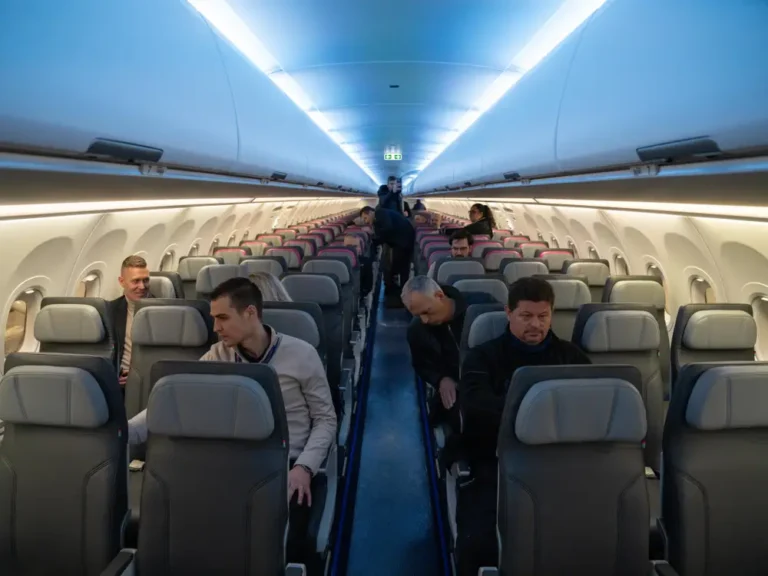I saw how New York’s biggest airport wants to build a 5-star terminal. I’d actually look forward to flying through.

JFK’s New Terminal One hopes to achieve a Skytrax five-star ranking once it opens in 2026.
New York City’s biggest airport is getting a major facelift.
John F. Kennedy International Airport broke ground on a new Terminal One in September 2022. The 2.4 million-square-foot facility will live where terminals 1, 2, and 3 once stood, with the first facilities expected to open in 2026.
A private consortium is investing $9.5 billion to modernize the new terminal, focusing on safety, efficiency, and the customer experience. This is part of the Port Authority of New York and New Jersey’s $19 billion total investment in upgrades at the city’s largest airport.
And there’s no better time than now, as the industry sees record-breaking travel, with JFK considered among the most prominent international gateways in North America.
JFK hosts more than 70 airlines and handled about 62 million passengers in 2023. The new terminal is expected to expand passenger capacity, with carriers like Phillippines Airlines, Air France, and Italian low-cost airline Neos all pledging to fly in.
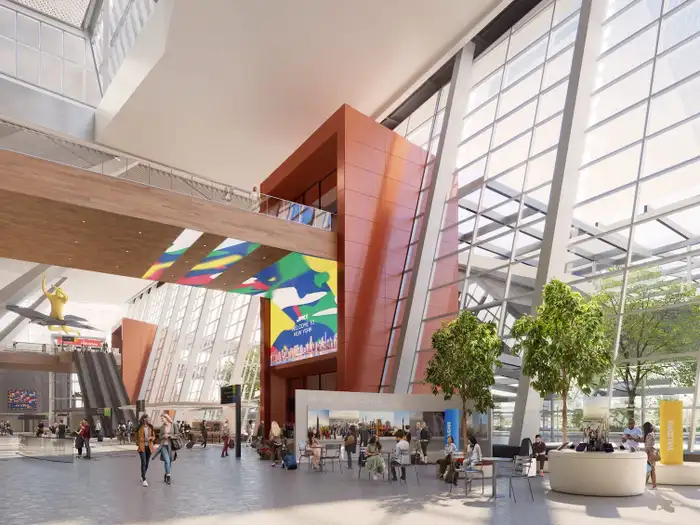
Rendering of the open spaces in the New Terminal One.
Developers hope the future state-of-the-art terminal will become a Skytrax five-star airport terminal — a feat no US airport had achieved until New York’s LaGuardia Airport finally ditched its infamous “LaGarbage” nickname with a new and improved Terminal B in 2023.
But to reach that status, JFK will have to overcome many long-standing problems, such as overcrowding and traffic congestion. In September, researchers from InsureMyTrip analyzed data from the Department of Transportation and found that JFK was among the worst airports for flight cancellations in 2024.
B-17, alongside other media, toured SITA’s pre-production testing center in Long Island to get a behind-the-scenes look at the technology coming to the new terminal to address the pain points of international travelers.
This includes facial recognition boarding, AI-powered gate systems, and air traffic technology to reduce the chance of near misses. If the technology works as promised, I’d look forward to flying through.
Customers can use their face to travel
Facial recognition has been installed at some airports across the country for international flights, including JFK’s revamped Terminal 8. In March, B-17 used biometrics to board a London-bound British Airways flight.
The new terminal wants to make facial recognition mainstream across the 23-gate facility.
The “e-gate” technology appeared easy enough to use for even less tech-savvy travelers. Flyers simply sign up for the service at check-in with their passport. Data is only stored for 24 hours, so travelers will have to do this step every time they fly.
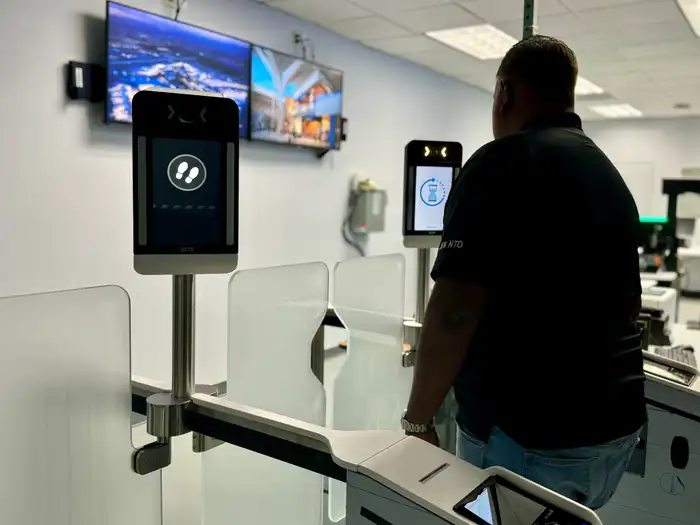
A JFK developer demonstrating the e-gate technology.
“E-gates mean no boarding pass and no ID required to board an aircraft,” a SITA developer said during the tour.
The developer said the technology is about 99% accurate and can distinguish between identical twins. The company acknowledged not every traveler would be comfortable with their face being used as an ID and said there would be manual lines available for boarding, too.
Meanwhile, the enhanced TSA will feature new biometric and touchless technologies to optimize wait times. Other terminals at JFK have already introduced similar face-reliant security features.
Concessions will be top-notch
While JFK will likely not offer a free movie theater or butterfly garden like Singapore’s famous Changi Airport, the new terminal will boast high ceilings, natural light, and plenty of retail spaces, lounges, and restaurants.
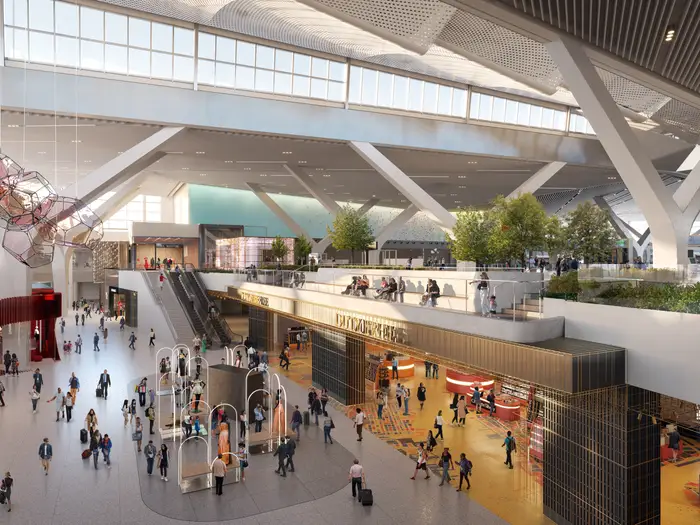
A project representative told B-17 that none of the brands have been unveiled and that the ones in the renderings are just placeholders.
Still, if the revamped Terminal 8 is any indicator, customers can expect “world-class” offerings, including luxury and local brands that represent NYC’s boroughs, and swanky new airline lounges that could meet the desired five-star status.
For example, Korean Air — a Skytrax five-star airline itself — plans to open one of its largest lounges yet with a kitchen and bar and a panoramic view of the airfield.
The new JFK aims for safer operations with fewer disruptions
Developers demonstrated technologies aimed at ensuring high levels of safety and traffic management — especially as near-misses continue to shake flyers.
One is a state-of-the-art ramp tower from technology provider ADB Safegate. This is where agents work to efficiently move aircraft around taxi and parking areas. It’s separate from the federally run air traffic control tower that guides aircraft to and from runways.
The technology includes a “virtual control tower” with screens that display live camera feeds across the ramp. This will assist in low-visibility conditions and improve awareness.
“There are cameras that allow a controller interested in a specific aircraft or a certain area of the airport, they can zoom in and zoom out to look at the area of interest,” ADB Safegate project manager Taha Zahir told media during the tour.
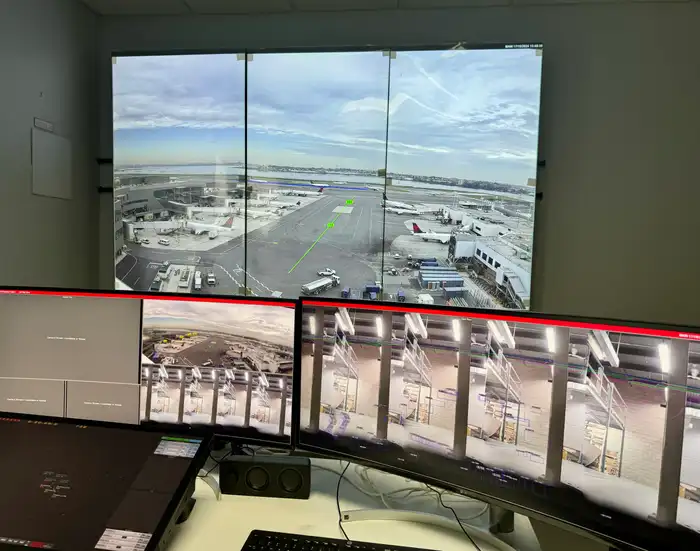
The tech also involves unique “e-strips” that help controllers manage flight delays and prioritize planes more easily. LaGuardia was the example loop on the screens.
Another ADB Safegate technology will be a parking aid that allows an aircraft to dock at a gate in virtually any weather condition. Zahir said this would be particularly useful during lightning storms when wing walkers are evacuated from the tarmac and forced to leave fully loaded planes sitting idle just meters from the gate.
Zahir said the docking system, which can handle everything up to the mammoth Airbus A380, is already proving its efficiency at existing JFK terminals and at several other airports like LaGuardia and Los Angeles.

The dock aid demonstrates how a regional jet would park at a gate. Zahir said the technology identifies each plane by its engines.
Complementing the gate and ramp tower tech is ADB Safegate’s AI-powered apron manager that can predict aircraft on-time performance and improve aircraft turn times — meaning passengers can get on their way faster than before.
“We have identified 25-30 activities that every flight must go through from arrival to departure,” Zahir said, noting things like fueling and baggage loading. “We know exactly what is going on with the aircraft.”


